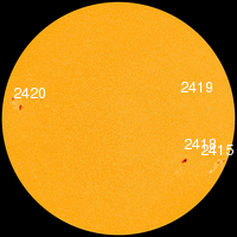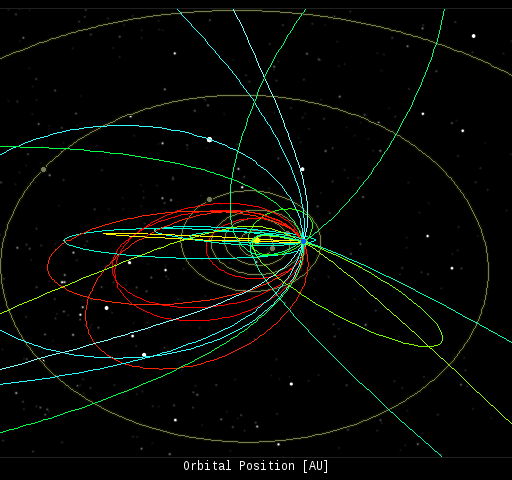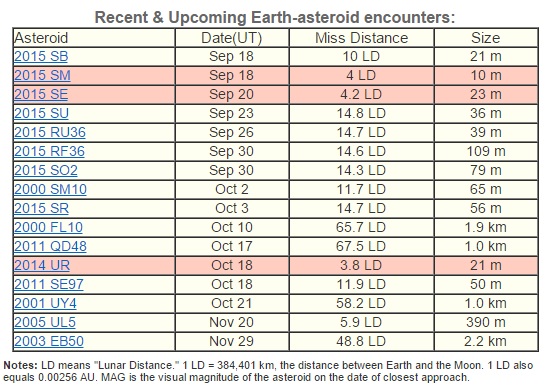| Online: | |
| Visits: | |
| Stories: |

| Story Views | |
| Now: | |
| Last Hour: | |
| Last 24 Hours: | |
| Total: | |
Internet’s Top News Headlines & Solar Activity Update
For reasons researchers don’t fully understand,auroras love equinoxes. At this time of year even a gentle gust of solar wind can spark a bright display. Tomorrow, Sept.23rd, is the northern autumnal equinox. Perfect timing: a CME is expected to deliver a glancing blow to Earth’s magnetic field on Sept. 23rd. The impact will probably be weak, but on the first night of autumn, weak may be strong enough. High-latitude sky watchers should be alert for equinox auroras. And no – there will be no comet impact tomorrow.
Every night, a network of NASA all-sky cameras scans the skies above the United States for meteoritic fireballs. Automated software maintained by NASA’s Meteoroid Environment Office calculates their orbits, velocity, penetration depth in Earth’s atmosphere and many other characteristics. Daily results are presented here on Spaceweather.com. On Sep. 22, 2015, the network reported 19 fireballs so far.
Near Earth Asteroids
Potentially Hazardous Asteroids (PHAs) are space rocks larger than approximately 100m that can come closer to Earth than 0.05 AU. None of the known PHAs is on a collision course with our planet, although astronomers are finding new ones all the time.On September 23, 2015 there were 1611 potentially hazardous asteroids.
NOAA Space Weather Prediction Center The official U.S. government space weather bureau
Atmospheric Optics The first place to look for information about sundogs, pillars, rainbows and related phenomena.
Solar Dynamics Observatory Researchers call it a “Hubble for the sun.” SDO is the most advanced solar observatory ever.
STEREO 3D views of the sun from NASA’s Solar and Terrestrial Relations Observatory
Solar and Heliospheric Observatory Realtime and archival images of the Sun from SOHO.
Daily Sunspot Summaries from the NOAA Space Environment Center
Heliophysics the underlying science of space weather
Columbia Northern High School Web-based high school science course with free enrollment
Aspendell California
Top Mainstream/Alternative News Headlines from around the Web for September 22, 2015
- Two Devils Converging On September 23rd—What They Discuss Will Have Serious Implications,this meeting lands on the Jewish Holiday known as You Kippur, it is also the 266th day of the year, which just so happens to line up with Pope Francis the 266th Pope.
- Bill Fleckenstein Warns This Is A Bear Market And The Buy The Dip Crowd Is Headed For Disaster
- Crazy! Giants come out of pit in Rugby World Cup 2015 (R$E)
- U.S. WILL STATION NEW NUCLEAR WEAPONS IN GERMANY AGAINST RUSSIA German Economic News also reports on Chancellor Merkel’s decision to allow these terror-weapons against Russia
- REPORT: GERMAN MEDIA COVERING UP RAPES COMMITTED BY MUSLIM MIGRANTS Top broadcaster refuses to air information on ‘darker skinned’ rapist
- THERE ARE INDICATIONS THAT A MAJOR FINANCIAL EVENT IN GERMANY COULD BE IMMINENT
- In Colorado and New York, Common Core Commerical Vendors Can Follow Your Child Into the Bathroom
- More than a dozen mysterious carved discs found near Volgograd, Russia
- Russian Central Banker Highlights Gold Manipulation – Nathan McDonald
- Ancient Egyptian Manuscript Found That Describes ‘Multiple Gates’ And Powerful Immortal Guardians At ‘Elaborate Architectonic Structure’A certain holy place that is protected by multiple gates and their powerful guardians.
- Vatican Prepping ET Signal? Jesuit Who Gave Tom Horn Several Interviews For ‘Exo-Vaticana’ And Believes That ‘Aliens Have Souls’ Is Named Director Of Vatican Observatory By Petrus Romanus
- A soldier’s best friend? Marines put Google’s robo-dog ‘Spot’ through its paces, tackling tough terrain and scouting buildings
- Facebook is spying on people around the world ‘just like America’s NSA’ says data protection watchdog during court hearing in Belgium where the company is accused of violating privacy laws
- A stock market crash is imminent: The convergence of factors that point to a market crash are more significant than those that led into the fall of 2008. The market is also more overvalued than the previous crash
- Susan Sarandon worries Pope Francis will be assassinated
- DO CORPORATIONS RUN A SOVEREIGN COUNTRY
- Liberal media outlet calls for disrespecting all Christians while comparing God to a rapist:HIT PIECE PROVES ‘WAR ON CHRISTIANITY’ MOVING FORWARD AT FULL SPEED
- Pakistani Mob Sets Christian Family’s Home on Fire to Burn Them Alive
- Nuclear Expert: US West Coast being continuously exposed to Fukushima radioactive releases, it’s an ongoing tragedy — Marine Chemist: Impossible to stop nuclear waste flowing into ocean;Radiation levels spiked 1,000% since floods
- 38 reasons why Obama is a Muslim:It is Obama who said at an Islamic dinner,’I am one of you.’
- Saudi Arabia Prepares to Execute Teenager via ‘Crucifixion’ for Political Dissent;THEY ARE BEING PUSHED TO HEAD HUMAN RIGHTS/WHAT AN ABHORRENT COUNTRY WHO TOTALLY DISREGARDS HUMAN RIGHTS_
- Syrian war spurs first withdrawal from ‘doomsday’ Arctic seed vault
- Blood Moon Rising: A mag 6.1 quake – Chile brings September the highest amount of major quakes in one month since April 2014…… Which coincidentally was the month of the first blood moon
- Franklin Graham Condemns Obama’s Guest List for Papal Welcome as ‘Sinful’ White House Invitation to Transgender Activists, Gay Bishop, Abortion Supporter Irks Vatican
- ‘Wake Up!’: Muslim Persecution of Christians, July 2015
Source: http://www.apparentlyapparel.com/news/internets-top-news-headlines-solar-activity-update






